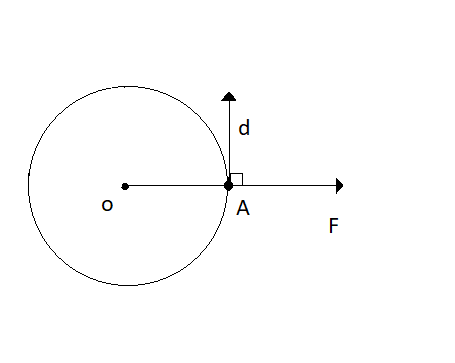
Work done by a centripetal force:
(A) Increase by decrease in radius of the circle.
(B) Decrease by increasing the radius of the circle.
(C) Increase by increasing mass of the body.
(D) Is always zero.
Answer
482.1k+ views
Hint :To solve this problem we should know about the basic concept of work.
Work: when force is applied on an object and it is displaced from its position in any direction. Then we can say that some work has been done.
Mathematically work will be written as: $ W = F.d = Fd\cos \theta $ .
Here, $ \theta $ is the angle between the force vector and the displacement vector.
Centripetal force: A force acting on a body to keep it moving in a circular path.
Complete Step By Step Answer:
As we know that the centripetal force causes the body to rotate in circular orbit and it acts in outward direction and displacement will be in perpendicular direction to the centripetal force.

As given in the figure $ F $ is centripetal force and $ d $ is displacement of the object.
As we can see from the figure, the angle between direction force and displacement will be $ \theta = {90^ \circ } $ .
From the formula of force:
$ W = F.d = Fd\cos \theta $
We get,
$ \Rightarrow W = Fd\cos {90^ \circ } $
$ \Rightarrow W = 0 $
Hence we can observe from the above the work done by centripetal force will always be zero.
So, option (d) will be correct.
Note :
Force: A force is push and pull act upon an object which causes change in speed, direction or shape. It can be positive, negative or zero.
Displacement: the dislocation of an object from its mean position in any direction with respect to its mean position. It can be negative, positive or zero. But we know that distance can never be a negative quantity.
Centripetal force only came into existence only when circular motion existed.
Work: when force is applied on an object and it is displaced from its position in any direction. Then we can say that some work has been done.
Mathematically work will be written as: $ W = F.d = Fd\cos \theta $ .
Here, $ \theta $ is the angle between the force vector and the displacement vector.
Centripetal force: A force acting on a body to keep it moving in a circular path.
Complete Step By Step Answer:
As we know that the centripetal force causes the body to rotate in circular orbit and it acts in outward direction and displacement will be in perpendicular direction to the centripetal force.

As given in the figure $ F $ is centripetal force and $ d $ is displacement of the object.
As we can see from the figure, the angle between direction force and displacement will be $ \theta = {90^ \circ } $ .
From the formula of force:
$ W = F.d = Fd\cos \theta $
We get,
$ \Rightarrow W = Fd\cos {90^ \circ } $
$ \Rightarrow W = 0 $
Hence we can observe from the above the work done by centripetal force will always be zero.
So, option (d) will be correct.
Note :
Force: A force is push and pull act upon an object which causes change in speed, direction or shape. It can be positive, negative or zero.
Displacement: the dislocation of an object from its mean position in any direction with respect to its mean position. It can be negative, positive or zero. But we know that distance can never be a negative quantity.
Centripetal force only came into existence only when circular motion existed.
Recently Updated Pages
Vedantu JEE/NEET Scholarships 2025: Apply Now

Reading Comprehension Stories with Questions & Answers – Free PDF

Order of Operations Worksheets for Class 3 with Answers

Class 5 Maths 4 Operations Word Problems Worksheet PDF

Class 1 Reading Comprehension Read and Color Worksheets PDF

Biology Explained: Branches, Topics & Essentials

Trending doubts
1 ton equals to A 100 kg B 1000 kg C 10 kg D 10000 class 11 physics CBSE

Difference Between Prokaryotic Cells and Eukaryotic Cells

One Metric ton is equal to kg A 10000 B 1000 C 100 class 11 physics CBSE

1 Quintal is equal to a 110 kg b 10 kg c 100kg d 1000 class 11 physics CBSE

Proton was discovered by A Thomson B Rutherford C Chadwick class 11 chemistry CBSE

Draw a diagram of nephron and explain its structur class 11 biology CBSE




